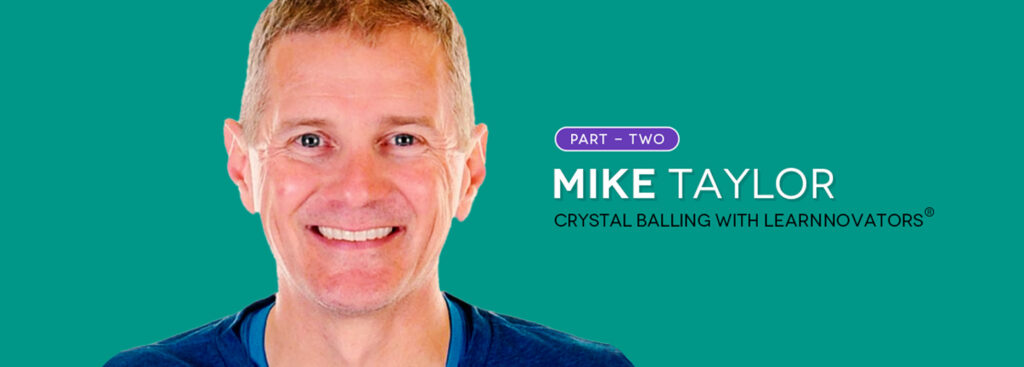ABOUT MIKE TAYLOR:
Mike Taylor advises organizations and consults on learning strategy, technology and implementation for Change4Growth, Ohio. He has also been serving the role of a Facilitator for Association for Talent Development (ATD) for over two years. Mike is known the world over for his role as the Community Manager at Articulate.
Mike has over 20 years of experience successfully developing and deploying a wide variety of learning strategies and technologies. He is known for his practical, street-savvy style of communication that helps him easily connect with his audience. He is popular for curating the best of the learning, design and technology news on his website.
Mike holds an MBA degree from Ohio University and a master’s degree in Learning Design and Technology from San Diego State University.
ABOUT THIS INTERVIEW SERIES:
Crystal Balling with Learnnovators is a thought-provoking interview series that attempts to gaze into the future of e-learning. It comprises stimulating discussions with industry experts and product evangelists on emerging trends in the learning landscape.
Join us on this exciting journey as we engage with thought leaders and learning innovators to see what the future of our industry looks like.
THE INTERVIEW:
Please note that this is Part 2 of the interview… Click HERE to read Part 1.
24. LEARNNOVATORS: How would you look at THIS view by Rachel Sibley (of Singularity University), that AR & VR are going to be the “operating systems of future workplaces”?
MIKE TAYLOR: While I’m excited about the potential for AR/VR applications, I haven’t done much work in this area. As with any new technology, we’ve always got to make sure we’re using it properly and not using it just because it is the latest, shiny, new, trendy thing. I can see some really cool applications of this in the future that could truly put learning “in the flow of work” and hence be hugely valuable.
25. LEARNNOVATORS: As per the LinkedIn 2018 Workplace Learning Report, ”getting employees to make time for learning” has been identified as the #1 challenge facing talent development.” The report further suggests meeting learners ‘where they already are’ to address this challenge. Here, we are reminded of Josh Bersin’s concept of ‘’learning in the flow of work’ that has gained significance in the industry today. We are inspired by his recent post with many interesting trends and examples of forward-thinking companies that have started to ‘put learning in the flow of work’ than ‘sending people away for training’.
What strategies would you recommend for L&D to engage workers through the platforms they already use at work’?
MIKE TAYLOR: I agree that we should go where people already are instead of creating yet another place for them to go. (Unless we provide significant value, they probably won’t go there) I think there are three questions we can ask ourselves that can drive engagement for anything we do:
- What are their goals and pain points?
- What is the information they want?
- What is the awareness they need?
26. LEARNNOVATORS: What will future authoring platforms look like when they start allowing learning designers to craft learning experiences that can be embedded in employees’ ‘flow of work’?
MIKE TAYLOR: Learning in the flow of work is becoming more and more possible with some of the new platforms. Obviously, the ability to access what you need in a sort of “on demand” or “as needed” way is better than sending people away for training. There will always be some need for face-to-face training. I just think it will be a much smaller proportion of our learning activities than it has been in the past.
27. LEARNNOVATORS: Traditionally, L&D has revolved around the creation and delivery of content. However, Donald H Taylor’s The 2019 L&D Global Sentiment Survey shows that now the sentiment is shifting towards personalized learning that is supported by data. As Donald puts it, “this current enthusiasm around data will likely take many years to manifest itself in L&D’s daily work. Whether L&D has the ability to interpret and work with that data is another matter.” We couldn’t agree more with Donald; this is an area that is going to be most challenging for L&D indeed. In fact, we believe that L&D will soon also be held accountable for the ‘results’ of their initiatives.
What is the trend? How has the industry started responding to this trend of leveraging the power of data to analyze the impact of their work?
MIKE TAYLOR: I think L&D should strive to show the data supporting our results. Often this can be challenging to do, but we should always look for metrics and other indicators that show what we are doing is having a positive impact on the results our organizations are seeing.
While it is easy to see the benefit, and while the trend is moving towards an increase in the data available to L&D teams, I still think a big majority have yet to take initial steps in this direction.
28. LEARNNOVATORS: We are greatly inspired by this call for action by The Corporate Rebels: “It is not always easy to be a rebel – to be the troublemaker continuously challenging the organizational status quo. But the success of the NASA rebels shows that rebels are exactly what organizations need. And why we need more.”
We too believe that, in today’s learning landscape, the community is in dire need of ‘learning rebels’, ‘agents of change’, and ‘learning provocateurs’ more than ‘learning conformists’. Because we are going through a time of major learning transformation, radical thinking that will help us get started on the transformation has become quite critical. Being a change agent yourself:
- Why do you think it is important to be a changemaker in our profession?
- What does it take to be a learning rebel?
- Who are some of the learning rebels you look up to?
MIKE TAYLOR: Isn’t the entire purpose of our existence as an L&D professional to be a changemaker? I think so. To me, being a rebel means not being stuck in traditional approaches or falling into the “that’s the way we’ve always done it here” mentality.
I admire anyone who goes beyond typical courses and looks for out-of-the-box ideas to affect meaningful change. From creative uses of approaches from other fields like marketing and repurposing technologies for learning purposes, there are a lot of people doing great things. Often, they are not officially L&D people. Maybe that is because they don’t have to unlearn all the traditional L&D approaches and have a broader toolkit of options to choose from.
The Corporate Rebels are a great place to start. People like Shannon Tipton, Bianca Baumann, Mark Britz, Jane Hart, Jane Bozarth and many others regularly share their “rebel” ideas and philosophies.
29. LEARNNOVATORS: You say, “It seems that many in L&D do what they see others do without questioning the validity/effectiveness of it. We should all be digging into the learning science and other relevant fields to gain a foundational understanding of what works, what doesn’t and why”.
Do you think e-learning, in its original format, is dead or has become irrelevant? What strategies would you propose to retain the relevancy of our learning programs?
MIKE TAYLOR: I still believe there is a valuable place for e-learning. I think it is evolving and it is still probably overused. Keeping so much content locked away behind an LMS is not going to lead to impactful changes our organizations need. I think we tend to over track our learning content when it could be much more valuable if it could be more easily shared and more widely discussed in an open forum.
30. LEARNNOVATORS: You have been voicing your concerns on the poor quality of e-learning courses that force learners to “stare at a screen and being frustrated by poorly implemented learning programs”.
Would you subscribe to the thinking that e-learning is yet to evolve to remain relevant in this digital and social age? If yes, what would be your suggestions for e-learning to step up? What would be some ideas for learning professionals to think and come up with solutions that can match with the other systems that we use today?
MIKE TAYLOR: I think Mark Britz captured this idea best when he said that “Organizations can’t scale learning when only a few people create content for the many to consume. The expectation has to change to where many people create and consume, learning together continuously.”
This also means that the definition of what e-learning is also needs to change. Modern digital tools make it easy for anyone to create learning content. Taken in this new perspective, I’m optimistic about the potential of digital learning.
31. LEARNNOVATORS: Here’s an excerpt from a thought provoking post by Marc Zao Sanders: “Learning & Development is the business function that time forgot. Technology is primitive: AICC and SCORM are 20 years old; even xAPI has been around since 2011; unsupported browsers like IE8 are commonplace in many firms; the UX of many learning systems is a 90s throwback. Content is stale: vast but substantially outdated content libraries sit unused on corporate LMSs, intranets, extranets, SharePoint etc. Research is outdated: Ebbinghaus’s forgetting curve is 100 years old and that’s one of the few learning mantras with some research to back it up. But there’s a chance to catch up with and even overtake modern business. To do that we need to look beyond where workplace technology is now, at where it’s going. Who cares where the puck is now? We need to know where it’s going to be by the time we can get there.”
What are your views on addressing these concerns?
MIKE TAYLOR: I tend to agree with that. As I’ve mentioned, I think there will always be a place for traditionally designed learning experiences. I just think the emerging technologies will free everyone to contribute and not limit them to the L&D department.
32. LEARNNOVATORS: Back in the day, formal learning was the only source of information or expert knowledge. However, that’s not the case today. Google and YouTube have changed the game so much so that we rely on these sources rather than workplace learning systems. The focus has shifted from ‘owning knowledge’ to ‘knowing how to access information to construct knowledge’. Given this context, we find it relevant to hear you say, “One of the things separating the best learning pros from everyone else is knowing when not to build a course. The most effective among us are moving beyond creating traditional courses to more efficient options like curating existing content instead of recreating the wheel. Increasingly, the best content is created by people outside the training department.”
What can learning designers learn from this for looking at designing a solution ‘beyond learning’?
MIKE TAYLOR: I think getting familiar and comfortable with concepts like 70:20:10, the 5 Moments of Need, the Behavior Engineering Model, etc. can go a long way to changing the perceptions and importantly the default solutions that many learning designers turn to.
33. LEARNNOVATORS: What would be the best approach to move away from ‘learning’ to ‘resources for performance support’?
MIKE TAYLOR: One way is to think about how we can be more efficient and responsive with the solutions we propose. There is a quote I once saw that basically said “never send a course to do what a good job aid can do”. In general, we should try to pull from a broader set of options and not get stuck in the “course mindset”.
34. LEARNNOVATORS: Would you agree with David James, Chief Learning Officer with Looop and an experienced Talent Management expert, who advocates for a purpose-built ‘resources first’ approach that respects the intelligence and the prior experience of learners in place of the conventional ‘e-learning first’ approach for immediate effectiveness at work?
MIKE TAYLOR: Yes! Absolutely!
35. LEARNNOVATORS: To quote Craig Weiss, “…this fourth industrial revolution is all about digital. The digital economy, which comes with a skill set that many folks are lacking in the workplace – digital skills?” We note that you too agree with the view that L&D needs to raise the bar around leveraging the potential of the digital skills.
What advice would you provide for L&D to close the digital skill gaps?
MIKE TAYLOR: I think one of the biggest things we can do is teach people how to learn. Most people don’t understand the myriad of ways they can facilitate their own learning. As L&D professionals, we should be modeling this and teaching everyone in our organizations how to build their own PKM systems.
To be continued. . . (Part 3 Coming Soon; Stay Tuned)






